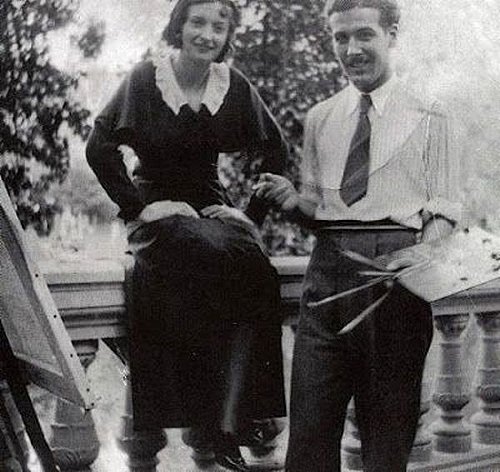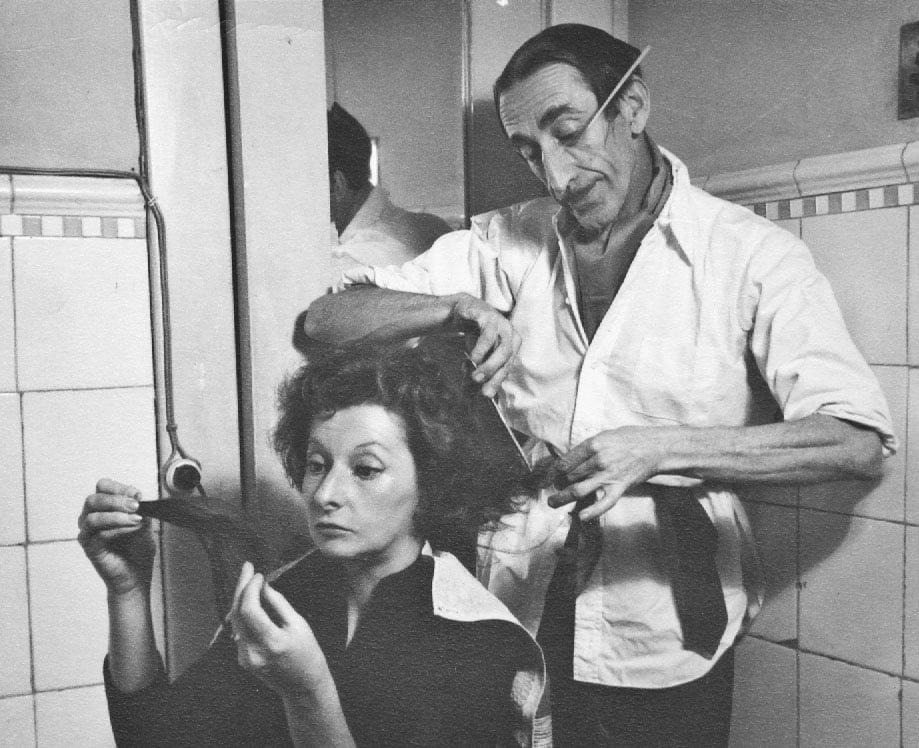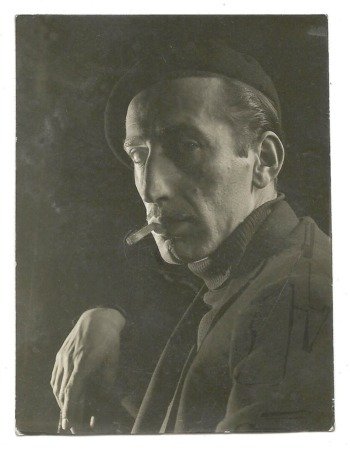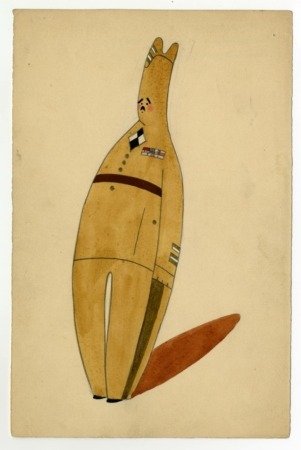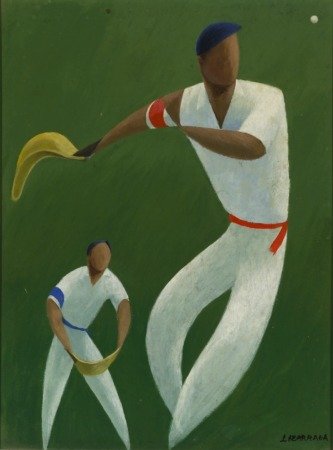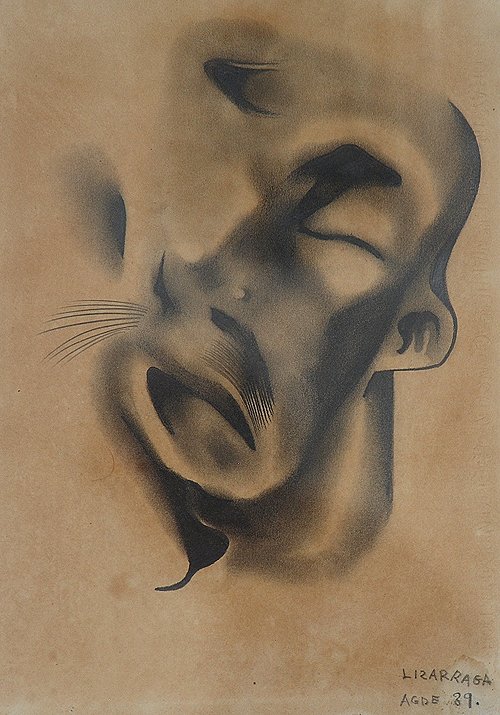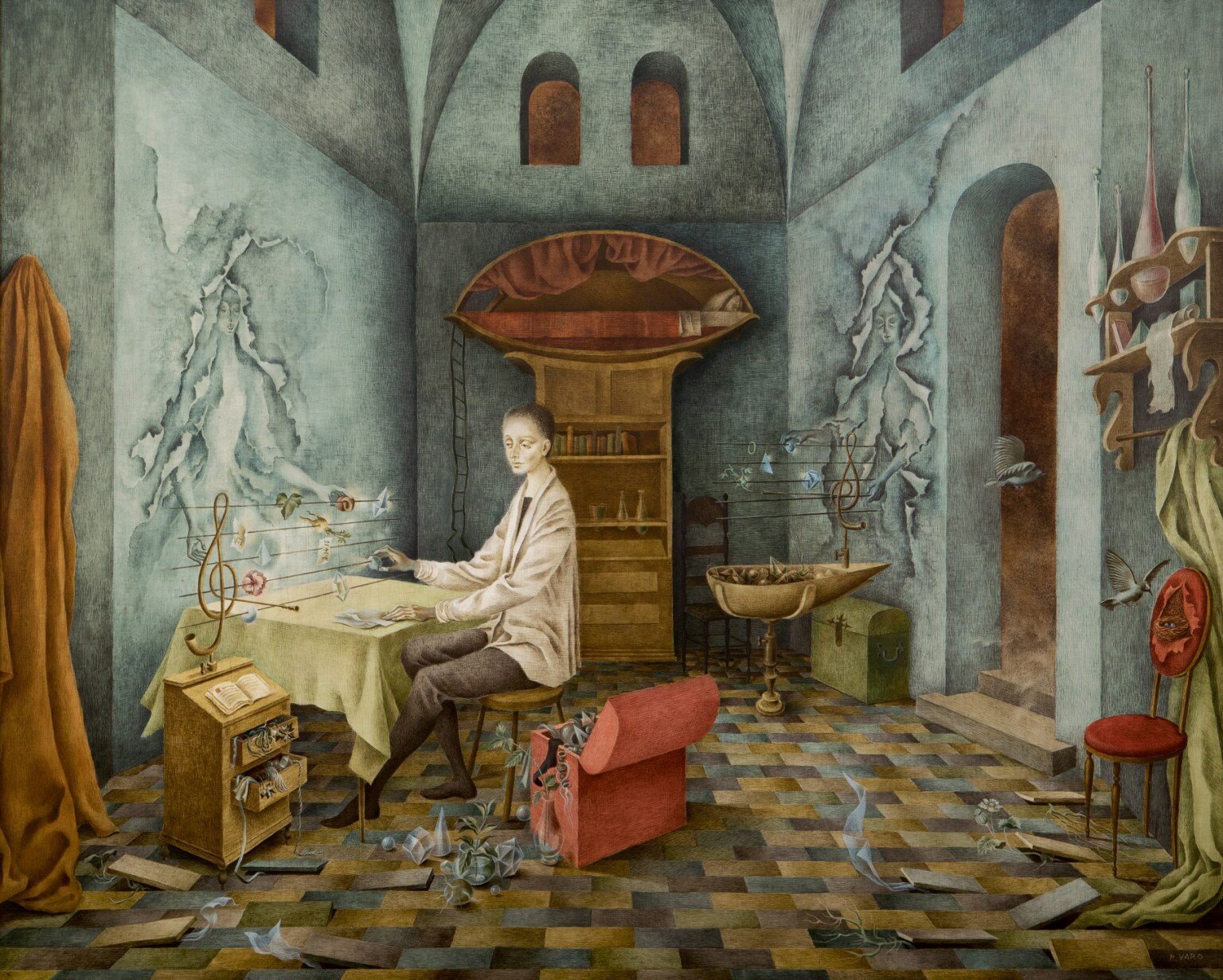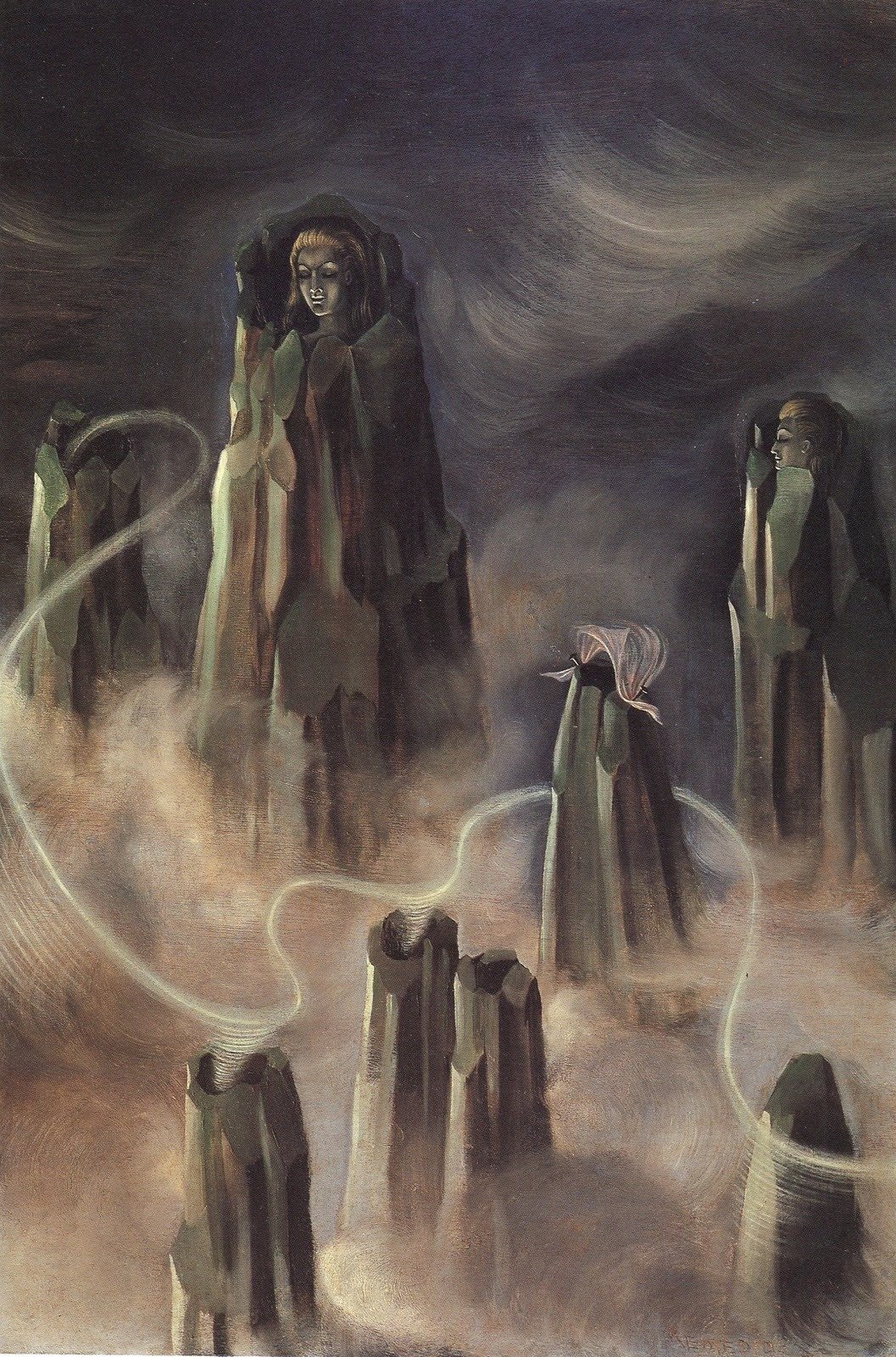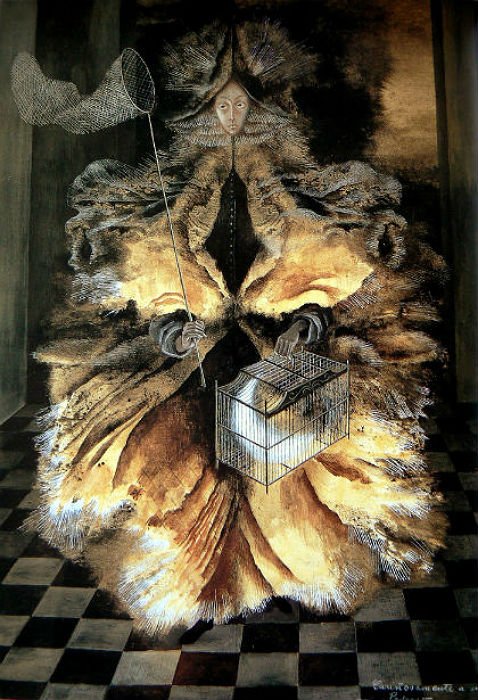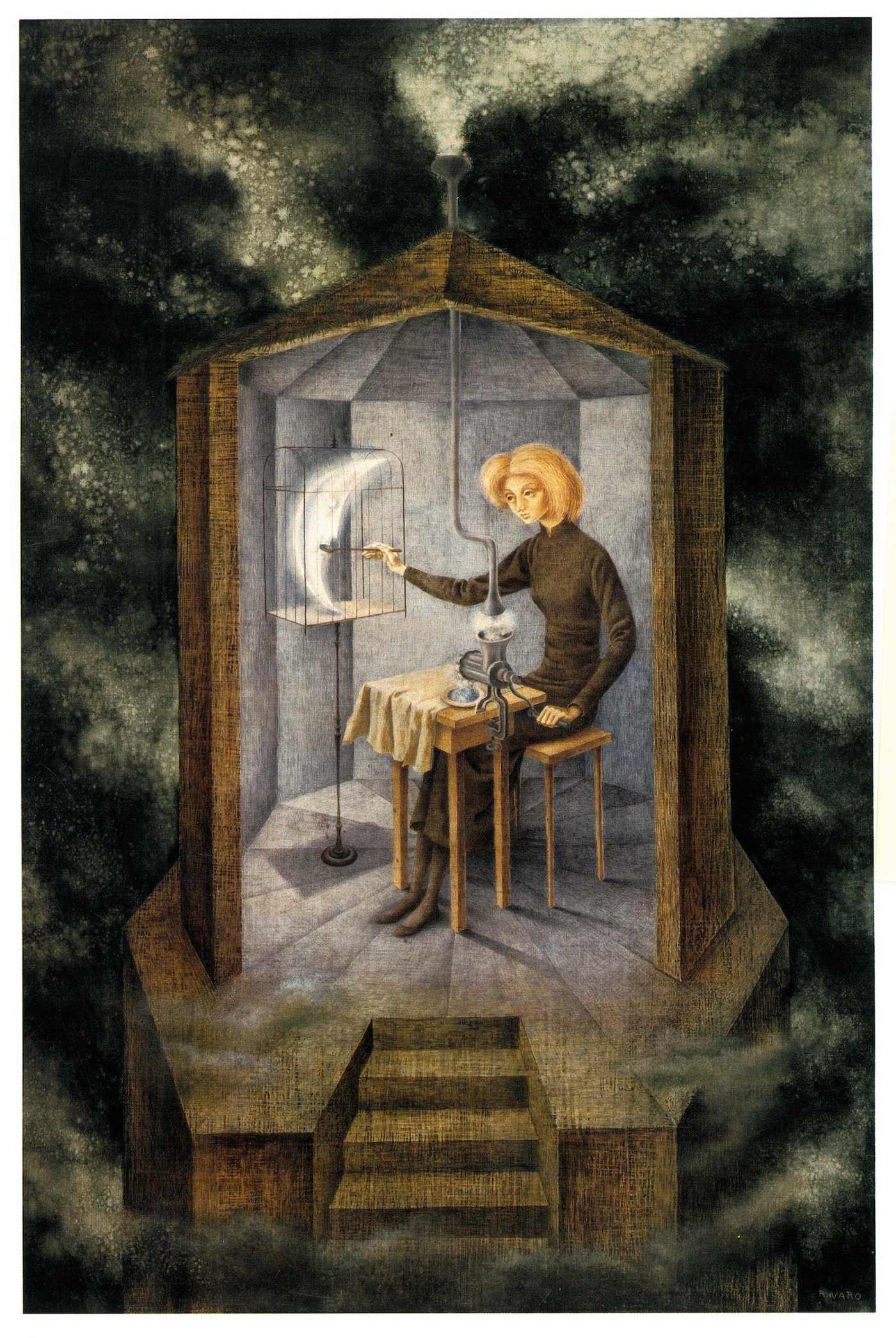Episode #114: Modern Love--Remedios Varo and Gerardo Lizarraga
Listeners, I heard you—a bunch of self-admitting hopeless romantics who wanted to hear more about people bound by attraction, fascination. By love. Though there are examples of romantic and sexual relationships between creators that are sprinkled throughout art history as we know it, it’s true that we have the most information about relationships from folks who lived in the last century—because we have greater access to documentation recording the lives of these people, and because, as the 20th century progressed, people—artists, perhaps especially—became more vocal about their relationships, less inhibited. Modern artists, artists especially from the first half of the 20th century, lived their art, and their relationships, out loud-- writing about them, talking about them, and sometimes even creating works of art about them.
This season, I’m rounding up stories about modern artists in love, in lust, in relationships— digging into these individuals, see how their liaisons, marriages, affairs, and connections played in or on their respective works of art, and how, if anything, they affected art history as we know it. I, for one, believe that it’s time for Modern Love.
Today: let’s get to know artists Remedios Varo and her first husband, Gerardo Lizzaraga.
Please SUBSCRIBE and REVIEW our show on Apple Podcasts and FOLLOW on Spotify
SPONSORS:
Lume Deodorant: Control Body Odor ANYWHERE with @lumedeodorant and get over 40% off your starter pack with promo code ARTCURIOUS at lumedeodorant.com/ARTCURIOUS! #lumepod
Shopify: Sign up for a one-dollar-per-month trial period at shopify.com/artcurious
To advertise on our podcast, please reach out to sales@advertisecast.com or visit https://www.advertisecast.com/ArtCuriousPodcast
Episode Credits:
Research by Ana Fuentes. Production and Editing by Kaboonki. Theme music by Alex Davis. Additional music by Storyblocks. Logo by Vaulted.co.
ArtCurious is sponsored by Anchorlight, an interdisciplinary creative space, founded with the intent of fostering artists, designers, and craftspeople at varying stages of their development. Home to artist studios, residency opportunities, and exhibition space Anchorlight encourages mentorship and the cross-pollination of skills among creatives in the Triangle.
Recommended Reading
Please note that ArtCurious is a participant in the Bookshop.org Affiliate Program, an affiliate advertising program designed to provide a means for sites to earn advertising fees by advertising and linking to bookshop.org. This is all done at no cost to you, and serves as a means to help our show and independent bookstores. Click on the list below and thank you for your purchases!
Episode Transcript
If you love ArtCurious, help us keep it going! Become a supporter at patreon.com/artcurious for as little as $5 a month.
Sometimes life is boring and average, and that can be wonderful. But sometimes, life comes at you in such an epic way that it almost seems false, like a novel, or a movie. But it’s not. It’s real life. And today’s story is one of those. It revolves around two painters, a world war, exile, a brief love story, the development of a lifelong friendship, and a photograph that, coincidentally and miraculously, may have saved a life.
Some people think that visual art is dry, boring, lifeless. But the stories behind those paintings, sculptures, drawings, and photographs are weirder, more outrageous, or more fun than you can imagine. ArtCurious Season 13 is all about Modern Love, and today’s episode features the ever-intertwined lives of Remedios Varo and Gerardo Lizarraga, two Spanish artists who never let any circumstance stop them from giving themselves entirely to their art, and creating some wonderful works that should be on your art historical radar. This is the ArtCurious Podcast, exploring the unexpected, the slightly odd, and the strangely wonderful in Art History. I'm Jennifer Dasal.
Our story today begins in Spain, with the much-hoped-for birth of a daughter in the small town of Anglés, in Girona, Catalonia, North-East of Spain, near the border with France. On December 16, 1908, María de los Remedios Alicia Rodriga Varo y Uranga was born to Rodrigo, a hydraulics engineer, and his wife, Ignacia. This new little girl was the second of the family’s children, but their first child, another girl, had previously died. In despair, the mother, Ignacia, made a promise to the Virgin Mary—in the form of the so-called “Lady of the Remedies,” that if she was blessed with a new daughter, she would celebrate the Virgin’s intercession in her daughter’s life, and her name. And thus, the little one would grow up to be known by the name Remedios, after Our Lady of the Remedies.
Like many who grow up to be artists, little Remedios Varo found delight and proficiency in drawing from a very early age. When her father, Rodrigo, noted her additional proficiency in math, he saw this as the powerhouse move that it is—art and geometry, lines and shapes, and so he took matters into his own hands to make sure that his daughter had the best artistic education available. He also took her to art museums, especially on trips to the Prado Museum in Madrid, where she fell in love with the paintings of Hieronymus Bosch, Francisco Goya, and El Greco. At the same time, he introduced her to science fiction novels, and she particularly took a shine to Jules Verne, whose visionary machines would later influence her own artwork. All of this made a huge impression on her, as did her cohort when she began studying at the Royal Academy of Fine Arts of San Fernando in Madrid, where she rubbed elbows with Luis Buñuel, Federico García Lorca, and Salvador Dalí, whom she later noted she found rather annoying. But no one made as much of an impression on her as the painter Gerardo Lizarraga.
Gerardo Lizarraga Istúriz was born in Pamplona, Spain on October 30th, 1905. As the son of the future mayor of Pamplona, Gerardo was exposed to the worlds of culture and privilege, studying at the best schools in the area and frequently joining his father on business trips to Paris. He was an accomplished student overall, but none more so than the visual arts, and by age 19 he had decided to pursue a career as a painter, enrolling at the Royal Academy of Fine Arts of San Fernando. And it was there that Remedios Varo caught his eye. Both artists were free-spirited, excited about making art and how they could reflect and affect the worlds around them via painting. Together, the artists worked, both of them slowly gaining prominence—in the case of Lizarraga—and competence—in the case of Varo, who, younger than her partner, sought continual training in Madrid while Lizarraga was granted both commissions and scholarships in Paris and beyond. But those two crazy kids didn’t let their careers get in the way of their love, so they married on September 6, 1930, with Varo a tender twenty-two years old, and Lizarraga, 25.
Though Remedios Varo had been born into a loving household, her parents were also rather strict, and she long felt confined in their presence. Marrying Gerardo Lizarraga, though, introduced her to a new world of freedom—including, especially, the freedom to follow her artistic muse. She began working in larger and larger formats, experimenting with that tempting new artistic and cultural direction—Surrealism—all while working through many of the inspirations she carried with her from her youth at home: her father’s interest in intellectualism and in literature, and her mother’s devout religiosity. We’ll come back to all of these—they’ll come into play later. But first, Varo and Lizarraga have to go to Paris.
We’ve already established the importance of Paris during this period as the epicenter of Surrealist art and thought, so it was a natural lure for painters like Varo and Lizarraga. But it especially made sense for and to Lizarraga, since he had previously spent two years living in the city while enjoying an art scholarship, as well as the previous visits that he made with his father during his youth. He felt comfortable there, and she did too, and both strove to cement themselves there. But it didn’t go as planned. For her part, Remedios Var enrolled in the famed École des Beaux-Arts, the state-sponsored art school, but she found it stifling and restrictive. She far preferred to study at her own pace and to follow her own whims, so she dropped out soon after enrolling. And Gerardo Lizarraga wasn’t having the best time, either—though he used his painting skills to great advantage during a stint as a scenery designer for ballets and operas back home in Spain, he wasn’t able to hold down a stable job in Paris. Broke, the Lizarragas had little choice but to return to Barcelona, where they had better connections and could better support themselves.
Let’s sidestep a little moment for a look at making a living in the arts. So, I can tell you that curators and art historians, unless you’re a superstar big-name museum person or maybe an art-historical novelist… well, we’re not rolling in cash. I can say that art podcasters aren’t living large, either, but it is what it is. Anyway. And though I’m not an artist, I know that many amazing creators struggle making a living out of their passions, too. Many folks grapple with feeling disappointment that they aren’t able to be quote-unquote “full time artists,” and that seems to have been difficult for both Varo and Lizarraga at this stage. However, they were full time artists, creating works meant for commercial use. And who’s to say that that’s any less an art form? Upon their return to Spain, they settled in Barcelona and husband and wife both took jobs with the J. Walter Thompson advertising firm, with Varo as a designer and Lizarraga as an art director. In their off-hours, they both practiced their art for themselves, and similarly nurtured their connections to Barcelona burgeoning contemporary art scene, joining a group known by the acronym ADLAN, which stood for “Amics de l'Art Nou,” a Catalan phrase meaning “Friends of New Art.”
Among ADLAN’s core group of painters, Remedios Varo fit right in. She was admired for her spirit, her feisty personality, her beauty, and her wit. One of her friends, the artist Óscar Domínguez, began calling her “The Lioness,” an affectionate teasing that showcased her strength and fierceness. And it was a fierceness, an adherence to her own beliefs and following her own path, that led to some difficulties with her husband. Like Lee Miller in our last episode of ArtCurious, Remedios Varo didn’t want to be tethered to just one sexual or romantic partner. And she found someone new and exciting in the form of Esteban Francés, another painter who was part of the ADLAN group. Francés, as Lizarraga had, fell head over heels for Remedios, and the two became so entwined that they not only became lovers, but moved into an art studio together, collaborating on paintings, collages, and, in true Surrealist fashion, exquisite corpse drawings—where one person would draw on a segment of paper before turning it over, hiding their drawing, and allowing the other artist to add to the drawing or to complete it, the result being a fantastic mishmash of styles and/or subject matter. Some incredible collage versions of Varo’s exquisite corpses still survive today, and they are excellent fun. You can see examples on my website: artcuriouspodcast.com.
Understandably, the more that Remedios meshed together with Esteban Francés, the more her marriage with Gerardo Lizarraga fell apart. They began spending more and more time apart, essentially living separate lives, until, around 1935, Varo fell in love with someone new—the French Surrealist poet Benjamin Péret. With the start of the Spanish Civil War in 1937, Varo and Péret fled to safety in Paris—with Esteban Francés, by the way, who was still in love with Varo. The three of them settled into an apartment together, and Lizarraga was left behind.
There’s more coming up next--right after this quick ad break—remember that you can join us over on Patreon for a few bucks a month and get this show ad-free: patreon.com/artcurious.
Welcome back to ArtCurious.
Back in Paris again, Remedios Varo was living her Surrealist dream. Through her relationship with Benjamin Péret, she was introduced to the inner circle of the Surrealists, befriending André Bretón, Max Ernst, Joan Miró, and many others, including the woman who would become her bestie, the equally fascinating painter Leonora Carrington. We mentioned her briefly in our first episode of the season about Max Ernst and Dorothea Tanning, as she was romantically connected with Ernst, too. Such delicious and international company, so full of ideas and open to such depths of experimentation, was a delight for Varo, and she took it all in, trying new techniques like fumage—an art technique developed by Varo’s friend, Wolfgang Paalen, using the smoke of a candle or a kerosene to create images on a piece of paper or directly onto canvas—or decalcomania, the transferring of prints or engravings onto pottery or other decorative materials. From the Romanian painter Victor Brauner, Varo dove deeply into texts about magic, esoterism, and alchemy. She studied texts about space and time, fascinated by questions about reality and interdimensionality. All of this percolated in the back of her mind, bubbling up in works like 1938’s The Souls of the Mountain, where the forms of women merge with those of mountains-slash-volcanoes, towering over a misty landscape below. It’s strange, dreamlike, weird and wonderful. It’s a fascinating piece by a Surrealist just beginning to come into her own—but we’re going to have to wait a little while longer before Remedios Varo really hits her stride.
Gerardo Lizarraga, too, was having a bit of trouble finding equilibrium after his wife left him and moved away to Paris. His resume at this point reveals someone with varied interests and maybe a little trouble holding down a job—or perhaps he liked it that way, loving that freelancer’s gig lifestyle. Between 1937 and 1939, he became an art professor, founded a film company, worked as a screenwriter and an art director’s assistant. He became a scenery and costume designer, and even acted in at least one film, all while Spain was roiling in the civil war. He made motivational posters to support the Basque army during the war, too. But after general Francisco Franco’s army took control of Catalonia, the Spanish Civil War was declared over, but many—including Lizarraga—didn’t feel safe. Alongside half a million others, Lizzaraga moved into France to seek refuge.
In our earliest episode this season, all about Max Ernst and Dorothea Tanning, I mentioned that Ernst himself had been imprisoned in 1939, seen as a potential spy in the early days of World War Two, when suspicion of anyone with German connections, like the German-born Ernst, was considered problematic at minimum, a purported threat to the safety of French citizens. At this same time, the French government acted to imprison around 350,000 Spanish exiles, too, accusing them of being, quote, “undesired foreigners.” Lizarraga was one such undesired foreigner. He was captured and forced to a concentration camp in Argelès-sur-Mer, a tiny village in the South of France, close to the Spanish border.
What I find most fascinating about Lizzaraga’s time as a prisoner in France is that he continued to work on both professional and artistic endeavors. I imagine that this helped him sort out his emotions, keeping busy, perhaps, and not dwelling despairingly on his lost freedom. During his internment, he not only sent detailed correspondence to his film production company, offering ideas and direction for their latest projects, but he also continued to draw, entertaining himself and his fellow prisoners with little caricatures of the officers and supervisors of the camp. These caricatures are done with bold color and sharp, swooping lines, humorously exaggerating the shape and sizes of various officers. My favorite presents a French lieutenant-colonel dressed in wartime khakis and a black-and-white tie, and the figure is more bowling pin than person. Gerardo Lizarraga kept these drawings, later referring to them as, quote, “the strongest and most important [part] of my artistic work.” Not that every work was humorous. Other drawings, in sparse graphite, survived, like Anguish, from 1939, a presumed self-portrait that morphs Lizarraga’s bewhiskered face into a moan that perfectly describes the work’s title. Another drawing, titled Mother Earth Fenced in with Barbed Wire, is hard to read: is the female form at the bottom of the image the personified Earth? And thus, is it her tortured, damned soul rising above and imprisoned behind that barbed wire? But that wire perfectly places its inspiration in the camp, a reminder that Lizarraga was trapped, and that his connection to creativity was one of his only means of emotional sustenance. In the midst of one of the darkest periods in his life, art helped save him.
But as to his whereabouts, and even if Gerardo Lizarraga was alive or dead, many—like Remedios Varo—didn’t know. Sure, she cared, but she was also so intermingled with the Surrealists, actively working and exhibiting, and she was still romantically connected to Benjamin Péret, if not to Esteban Francés. She essentially lost track of her estranged husband for a few years. But in the early 1940s, a single event changed everything, and brought Lizarraga back into her life.
One afternoon, Varo and Péret were enjoying an afternoon out at a movie theater in Paris. While they waited for the feature to begin, they casually watched the news reels—you know, what they used to show in theaters before previews were a thing—and happened to catch a report on the Spanish refugees that had crossed the border in the aftermath of the Spanish Civil War, many of whom were now, they learned, captured and held in internment camps throughout the South of France. Photos of various Spanish exiles flashed across the screen, and all at once, Remedios Varo felt her heart skip a beat, because she recognized one of them: it was none other than her husband. Can you imagine? What if Varo and Péret opted to skip the movies that day? What if this reel wasn’t shown in that theater? What if Varo was late to the movies, or happened to look away from the screen at exactly the wrong moment? In a flash, she learned of the whereabouts and status of one of the people most important in her life—or at least used to be. Her husband was alive, and he was in France, trapped in a camp against his will.
Before Varo could stop herself, she ran to the cinema’s projection booth, explaining the odd but fortuitous situation—that was her husband on the screen, could she please have that single still frame from the news reel? Reluctantly, the projectionist snipped the frame, and Remedios Varo left with this small proof that Gerardo Lizarraga was still alive.
For nearly two years, Varo worked tirelessly, requesting intercession from the French government to release her husband. I am his family, she declared. I can vouch for him, I can claim him as one of us, I will take care of it, she begged. And though the French government had a remedial intercession program in place that allowed exiled prisoners to be released with the assistance of friends and family, it proved harder to put in practice than it was to manage on paper. And then things only got worse. Though Varo attempted to have Lizarraga freed, he was then transferred in 1940 to a different concentration camp, this time in the tiny town of Agde, and his estranged wife again lost track of him. And then things grew dim in Paris, too, after Hitler’s army invaded France. After the occupation began, many of the Surrealists—including Péret and Varo—were arrested, interrogated, and tortured for their known opposition to fascism. Varo herself was imprisoned for several months,
Under the threat of continued torture, exile, or even death, Varo made the only decision she felt that she could: she, alongside several acquaintances, fled Paris, slowly making her way to the South of France, toward, she hoped, her captured husband. She was living in hiding, living in fear, and it was only when she reached Marseilles and connected with a larger group of international expats attempting to flee Europe that she felt safer. Lizarraga, meanwhile, has coincidentally and finally been freed of his final place of captivity—a camp at Clermont-Ferrand, and he traveled to Marseille, where he reunited with Remedios Varo, who had spent so long working to secure his freedom.
Varo and Lizarraga were still married, legally—and though they were no longer in love, or at least not in the same way, they felt forever bonded by the trauma of the intervening years since they separated—the Spanish Civil War, the World War, their status as exiles and Spaniards living abroad. So it makes sense, at least in some ways, that they chose to stick together. They finally received exit papers to depart France in 1941—through the heroic efforts of American journalist Varian Fry and the Emergency Rescue Committee who secured safe passage for many anti-Nazi refugees in the early 40s, including not only Varo and Lizarraga, but also Marcel Duchamp and Max Ernst, as just a few examples. Though many of their cohort chose to emigrate to the U.S., Varo and Lizarraga opted instead to move to Mexico, partially due to their built-in knowledge of the Spanish language. And thus, in the early 40s, they found themselves settling again in a new country, supporting each other not as lovers and spouses, but as friends, still inspired by the same exciting art and ideas that had brought them together decades before.
Over the years as they established their lives in their adopted home, Varo and Lizarraga had multiple opportunities to work together, including for an incredible commission from the Ballet Theater of New York (today known as the American Ballet Theater), where they worked in Mexico City with none other than Marc Chagall to create the scenery and costumes for the ballet “Aleko,” based on a work by the Russian poet Alexander Pushkin. Both artists remarried but still remained extremely close friends, with Lizarraga’s children often visiting Remedios Varo’s home for extended afternoons filled with drawing kid-versions of exquisite corpses and making collages, and even heading to the beach at Acapulco with her. Their families, still and forevermore, stayed entwined.
And the families even supported each other’s art careers, too. There’s one lovely story where Lizarraga’s then-wife, nicknamed Ikerne, offered advice to a nervous Remedios, who was about to show her paintings in a group exhibition in Mexico City for the very first time. It had been a while since she had enjoyed exposure for her artworks, let alone in a large city and as part of an exhibition of an artwork collective, and she didn’t know exactly how to price her works. She visited Ikerne for help, worrying aloud, “How do I know what my paintings are worth? What if I price them too low? What should I let them go for, for what amount?” And Ikerne, after a moment, said, almost jokingly, “Well, do you think any of your paintings will actually sell?” Remedios Varo, embarrassed, said no. Ikerne then responded, “Well, in that case, put them at a very high price.” So Varo did. And each and every one of her paintings in the exhibition sold, a coup that shot Varo’s name into the stratosphere of the art world in midcentury Mexico City. This led to more exhibitions, more sales, and more commissions. Let this be a lesson for all of us when it comes to value and our own self-worth. We are worth a high value. You are worth it.
To be fair, it shouldn’t have been a surprise to Remedios, or Ikerne, or Gerardo or any of their circle that Varo’s works would become so sought-after. After Remedios married her husband, Walter Gruen in 1950, she grew extremely prolific and inspired, creating painting after painting suffused with folkloric and occult-inspired symbols, detailing scenes with seemingly built-in narratives. Prior to the early 1950s, Varo had remained dedicated to her art practice but still pursued commercial work and graphic design to fund her passions and her lifestyle. Gruen, though, proved to be an undying supporter, suggesting that Varo stop working commercially and start pursuing her own work full-time. So she did: and it might be no surprise to learn that at this point, her paintings grew more interesting, more self-assured. Many of her works feature a female protagonist, many in the midst of their own acts of creation or care, such as feeding a crescent moon in 1958’s Celestial Pablum; creating music out of disparate objects with the help of strange women appearing out of the peeling wallpaper in Harmony, from 1956; or, one of my favorites, another 1956 work called The Weaver of Veronica wherein a lone woman knits another—an angelic red creature, hovering in the air—into existence. The more you look at Varo’s works, the more fascinating they become. They’re complicated, still in that imaginative Surrealist vein, and many championing women as their central protagonists. Sometimes they are difficult to disentangle or to interpret, but in the best possible way. And as the past half-century has progressed, it’s exciting to see how much Varo’s works have grown in esteem, how much more popular she has become. Today, she’s often considered one of the most fascinating artists who lived in midcentury Mexico, often making “best-of” lists alongside Frida Kahlo, Diego Rivera, and others.
I only wish I could tell you that she lived longer. Her career had really just begun cresting when she died of a heart attack at the age of 54 in October 1963. But that last half-decade or so of her life? Wow. That’s when she was most prolific, most inspired, and created the vast majority of her surviving works.
If anything, this should probably have been the story of the love of Walter Gruen for Remedios Varo, his emotional and financial backing that allowed her to achieve her much-longed-for goals of working as an artist full-time. And while I don’t doubt that Varo would not have achieved so much without his love and care, I still feel the same way about her first marriage, too, her connection to fellow artist Gerardo Lizarraga. They came together at an early point in their lives, and when Lizarraga was the more prolific of the two, the promising artist whose career first took them to Paris, the place that Remedios Varo found so much life and meaning as a part of the Surrealist community. Year later, after they parted as a romantic couple, their mutual support of each others’ works and families carried both—but especially Varo—to feel secure and complete, to feel held and understood. Not every romantic pairing, or grouping, should last. And just because they didn’t last doesn’t mean that they weren’t important or meaningful. Varo, in essence, saved Lizarraga’s life. And really, can there ever truly be a greater example of one’s love or care for another being?
Next time on ArtCurious, it’s potentially the most collaborative and creative couples we’re featuring this season. I love this episode, and both of these artists, and you’re not going to want to miss it.
Thank you for listening to the ArtCurious Podcast. This episode was written, produced, and narrated by me, Jennifer Dasal. HUGE thanks to Ana Fuentes for her great writing and research help for this episode. The ArtCurious theme music is by Alex Davis at alexdavismusic.com, and our podcast is co-produced by Kaboonki - podcasts, creative video, and more. Subscribe to their show, Subgenre, a podcast about the movies, available on Apple Podcasts, Spotify, and at subgenrepodcast.com. Kaboonki: Leave your mark. The ArtCurious Podcast is sponsored primarily by Anchorlight. Anchorlight is a creative space, founded with the intent of fostering artists, designers, and craftspeople at varying stages of their development. Home to artist studios, residency opportunities, and exhibition space, Anchorlight encourages mentorship and the cross-pollination of skills among creatives in the Triangle. Please visit anchorlightraleigh.com.
The ArtCurious Podcast is also fiscally sponsored by VAE Raleigh, a 501c3 nonprofit creativity incubator, which means you can donate tax-free to ArtCurious to show your support, and you can join us at Patreon for the price of a cup of coffee. Check back with us soon as we explore some of the most unexpected, slightly odd, and strangely wonderful Modern art lovers in art history.


